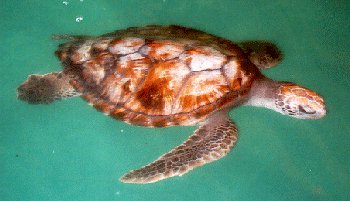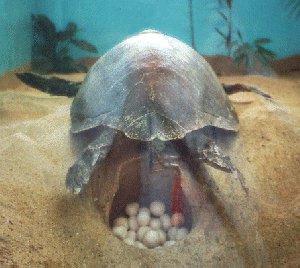Of Turtles and Things
Of Turtles
and Things
From the Jul/Aug 1996 issue No. 30 of the
Mexican Meanderings Newsletter.
Why and Where
A few miles west of the small and delightful fishing village of Puerto Angel, on Oaxaca's Pacific coast, lies the even smaller fishing village and beach called Mazunte. A sign near the museum says that, according to INAFI (the National Institute of Archaeology and History), the word Mazunte evolved from a Nahuatl word (Maxontetia) meaning, in all its parts, "Please lay eggs." Until 1990, when Mexico outlawed the practice, Mazunte beach was an abattoir. Some 50,000 turtles were slaughtered each year as they came on shore to nest, and their weathered white bones and shells were strewn about for the tides and storms to remove. The creatures were viewed as an infinitely renewable source of turtle steaks and eggs. Endangered? Didn't they return by the thousands year after year after year? Then the numbers began to decline not only at Mazunte, but at other killing beaches throughout the world, and scientists realized that a crisis was at hand.
Not all the world heeded the message simultaneously, nor reacted with the same gusto. Demand for sea turtle eggs, oil, meat and shell was difficult to placate. The creatures were easy to find and kill, and offered no danger to the hunter. The international fishing industry still accounts for a large annual number of turtle kills through entrapment and drowning in nets. Turtle excluding devices (TEDs) for fishing nets are costly, and the industry objects strenuously to this added outlay. Ongoing pollution of the seas includes untold quantities of plastic bags, which to turtle eyes seem to bear an uncanny resemblance to a staple of their diet, the jelly-fish. Ingested, the plastic blocks the digestive tract, causing starvation.
Since 1984, Mexican scientists have held inter-university symposia and conferences on the subject of the marine turtle. By 1990, these experts had accumulated sufficient evidence of the plight of these "armored fish" (the chimalmichin or ayotectli of the ancients) to convince their government to impose a total ban on their harvest. Mazunte, the former killing beach, was chosen in 1991 as the site for the Centro Mexicano de la Tortuga (CMT). Located about 7 miles west of Puerto Angel, this laboratory and aquarium is dedicated to the study, protection and preservation of the sea turtle. At the same time it serves as an educational site, providing both local residents and tourists alike with a greater knowledge of their environment and of these fascinating creatures.
The modern plant includes a large main building containing central and peripheral tanks devoted to examples of the seven species of marine turtles frequenting the Mexican Pacific, Gulf and Caribbean beaches. A small gift shop is also resident here. Outside, beneath protective roofing, are large tanks for the observation of both juvenile and adult individuals. Other areas are devoted to laboratories for the study of their diet, development and life habits. Teams of biologists and veterinarians are ably supported by technical staff and student interns. And for five days in June of 1995, the Center hosted the Twelfth International Conference on the Conservation of the Marine Turtle.
Although the CMT functions primarily as a marine turtle research center, it is also known locally as the "Turtle Museum," for here may also be seen examples of Mexico's six species of fresh water turtles as well as the two species of land turtles. You have to look closely to spot the latter; they are usually well hidden in the small cactus garden created for their benefit. And all of this may be seen Tuesday through Sunday from 9am until 6pm. It is closed to the public only on Monday.
So what is this creature called a turtle? Surely you've always heard of turtle steaks, turtle soup, and tortoise shell combs and other ornaments. But did you know that these came from a reptile? Certainly much more endearing creatures than, say, snakes or iguanas, but reptiles nonetheless.
Mythology and History
The Marine Turtle has featured throughout much of recorded human history. Greek mythology credits Apollo with creating the first lyre by stretching strings across the shell of a sea turtle who had given his all for music. The ancient Mexicans ranked the turtle next to the goddess of flowers, while the Toltecs believed their ancestors rode on the backs of turtles in crossing the sea to arrive on this continent (near the site of present-day Veracruz). And throughout Asia the turtle is a principal in mythology.
Sea turtles have been around and recognizable for a long, long time, their fossils first appearing in rocks of the late Jurassic period, some 200 million years ago. During the course of the next 100 million years or so, one now extinct (thank goodness!) Late Cretaceous species attained a length of almost fifteen feet. He (or she) must have been truly formidable!
General characteristics
Eight species of marine turtles are recognized and all are found in the tropical and subtropical seas of our planet. Seven of these species frequent Mexican waters and are represented at the CMT. The green (so called because of the color of its fat), loggerhead, olive ridley, hawksbill and leatherback are found in the Pacific, Gulf and Caribbean. The black normally dwells only in the Pacific, while the Kemp's ridley is generally restricted to the Gulf of Mexico waters. The flatback sea turtle, the only one not found near the American continents, resides in Australian waters only. All marine turtles have lungs, but their oxygen exchange mechanism is unique. That, combined with a low metabolic rate, allows them to remain submerged for extended periods of time. Turtles are a delight to watch swimming; they soar through the water, sedately using their front flippers to propel themselves while steering with their rear flippers. Unlike their landlubber brethren, sea turtles cannot retract head and appendages within their shells.
In The Beginning
In spite of their need to breath air, marine turtles are truly "old salts," spending most of their life at sea. The principal exception is when the female returns (usually) to her natal beach to lay her eggs. Some species nest every year; others only every two or three years. The female ridley (olive and Kemp's) often come onshore in large groups (several thousand strong); locally these onslaughts are called arribadas, or arrivals. Once a few yards above the high tide line, each turtle scoops out a trough deep enough to keep her

Juvenile Green Sea Turtle
somewhat hidden while digging out a smaller egg chamber. Into this she deposits anywhere from 50 to 200 ping-pong ball size leathery-shelled eggs. She then covers the entire excavation with damp sand and heads back to sea. Depending on the species, she may linger a few days or weeks offshore then come back for another one or two egg-laying sessions. Or she may head straight out to sea and her normal feeding grounds. Not exactly a model of maternal domesticity. The role of the male is even more momentary in nature.
The eggs will incubate for some 6 to 10 weeks before the hatchlings break from the shell. Interestingly, their sex has been determined sometime after fertilization. Some experts believe sexual development may be a function of incubation temperature: warmer, more females or cooler, more males. Three or more days may be required for the three-to-four-inch hatchlings to dig their way to the beach surface. They usually break out at night and make their ungainly flight to the water, somewhat protected by the darkness from innumerable predators. Despite their numbers, scientists consider the survival rate to be very low. And little is known about where they go or what they do to survive during the next year or so.
Lifestyles
Marine turtles are migratory feeders and their feeding grounds are generally within 10 to 20 miles from the shoreline; however, for a particular species these grounds may be hundreds of miles away along the

Mock-up of turtle with eggs
on display at the Turtle Center
shoreline or even across wide expanses of ocean on another shore. Based on DNA testing, some loggerheads found feeding off the Baja California coast are believed to have hatched at nesting sites in Japan or even Australia. A turtle could get mighty hungry on that trip, even though all species are strong swimmers. Cruising speeds vary from about 1 mph (green) to almost 6 mph (leatherback). Sea turtles reach breeding age in from three years (hawksbill) to as many as thirty years (green). The life span of the smaller species is some 20 to 30 years, while the larger can reach ages of 50 to 80 years. Some are by preference vegetarian (green and black) while the others prefer to munch on mollusks, shrimp, crabs, jellyfish, etc.
The navigation system which enables these creatures to home in on their birth beach after several years and many hundreds of miles is a phenomenon shared by other seafarers (salmon for one) and aerialists such as swallows, monarch butterflies, etc. In the turtle, the capability is now thought to hinge on a metallic mineral in their brain which responds to the earth's magnetic field. Somehow the beach location is imprinted at birth or in the first few frantic hours or days of life before they embark on their lifelong voyage.
Future
The continued existence of the marine turtle is still not a certainty. The scientific world has become much more cognizant of the potential of their extinction over the past few years, and has been joined by governments, businesses and individuals in a effort to create a worldwide awareness. Poachers still take their toll, as do natural predators and, inadvertently, commercial fishermen. But with the dedicated efforts at stations such as the one at Mazunte, another on the northern Gulf coast of Tamaulipas, and elsewhere, Mexico has joined in the struggle to reverse a trend which a few years ago appeared inevitable.
Getting To Mazunte
As mentioned earlier, Mazunte and the Centro are a few short miles west of Puerto Angel, a bit out of comfortable walking distance if the day is very hot. However, an inexpensive local bus makes the run about every half hour, and taxis abound. The road, narrow and paved (sort of), parallels the beach. West of Mazunte it turns north to join the main coast road, Highway 200, which then connects to Puerto Escondido (about 35 miles west) or Pochutla and Huatulco (about the same to the east). Mazunte and the other nearby beach settlements offer rather rustic accommodations; you might be happier making this a day trip from Puerto Angel (see Mexican Meanderings #25, Sep-Oct 1995), Huatulco or Puerto Escondido (this issue). The many impromptu palapa restaurants do offer cold beverages and FRESH fish, and the swimming is delightful.